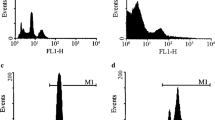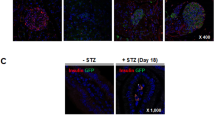Abstract
Allogenic islet transplantation is a most efficient approach for treatment of diabetes mellitus. However, the scarcity of islets and long term need for an immunosuppressant limits its application. Recently, cell replacement therapies that generate of unlimited sources of β cells have been developed to overcome these limitations. In this study we have described a stage specific differentiation protocol for the generation of insulin producing islet-like clusters from human bone marrow mesenchymal stem cells (hBM-MSCs). This specific stepwise protocol induced differentiation of hMSCs into definitive endoderm, pancreatic endoderm and pancreatic endocrine cells that expressed of sox17, foxa2, pdx1, ngn3, nkx2.2, insulin, glucagon, somatostatin, pancreatic polypeptide, and glut2 transcripts respectively. In addition, immunocytochemical analysis confirmed protein expression of the above mentioned genes. Western blot analysis discriminated insulin from proinsulin in the final differentiated cells. In derived insulin producing cells (IPCs), secreted insulin and C-peptide was in a glucose dependent manner. We have developed a protocol that generates effective high-yield human IPCs from hBM-MSCs in vitro. These finding suggest that functional IPCs generated by this procedure can be used as a cell-based approach for insulin dependent diabetes mellitus.









Similar content being viewed by others
References
Chen LB, Jiang XB, Yang L (2004) Differentiation of rat marrow mesenchymal stem cells into pancreatic islet beta-cells. World J Gastroenterol 10(20):3016–3020
Shim J, Kim S, Woo D, Kim S, Oh C, McKay R, Kim J (2007) Directed differentiation of human embryonic stem cells towards a pancreatic cell fate. Diabetologia 50(6):1228–1238
Zhang D, Jiang W, Liu M, Sui X, Yin X, Chen S, Shi Y, Deng H (2009) Highly efficient differentiation of human ES cells and iPS cells into mature pancreatic insulin-producing cells. Cell Res 19(4):429–438
Gao F, Wu D-Q, Hu Y-H, Jin G-X, Li G-D, Sun T-W, Li F-J (2008) In vitro cultivation of islet-like cell clusters from human umbilical cord blood-derived mesenchymal stem cells. Trans Res 151(6):293–302
Chao KC, Chao KF, Fu YS, Liu SH (2008) Islet-like clusters derived from mesenchymal stem cells in Wharton’s Jelly of the human umbilical cord for transplantation to control type 1 diabetes. PLoS ONE 3(1):e1451
Chang C-M, Kao C-L, Chang Y-L, Yang M-J, Chen Y-C, Sung B-L, Tsai T-H, Chao K-C, Chiou S-H, Ku H-H (2007) Placenta-derived multipotent stem cells induced to differentiate into insulin-positive cells. Biochem Biophys Res Commun 357(2):414–420
Okura H, Komoda H, Fumimoto Y, Lee C-M, Nishida T, Sawa Y, Matsuyama A (2009) Transdifferentiation of human adipose tissue-derived stromal cells into insulin-producing clusters. J Artif Organs 12(2):123–130
Colter DC, Class R, DiGirolamo CM, Prockop DJ (2000) Rapid expansion of recycling stem cells in cultures of plastic-adherent cells from human bone marrow. Proc Natl Acad Sci 97(7):3213–3218
Shiroi A, Yoshikawa M, Yokota H, Fukui H, Ishizaka S, Tatsumi K, Takahashi Y (2002) Identification of insulin-producing cells derived from embryonic stem cells by zinc-chelating dithizone. Stem Cells 20(4):284–292
Mosmann T (1983) Rapid colorimetric assay for cellular growth and survival: application to proliferation and cytotoxicity assays. J Immunol Methods 65(1):55–63
Li Y, Zhang R, Qiao H, Zhang H, Wang Y, Yuan H, Liu Q, Liu D, Chen L, Pei X (2007) Generation of insulin-producing cells from PDX-1 gene-modified human mesenchymal stem cells. J Cell Physiol 211(1):36–44
Chandra V, Swetha G, Muthyala S, Jaiswal AK, Bellare JR, Nair PD, Bhonde RR (2011) Islet-like cell aggregates generated from human adipose tissue derived stem cells ameliorate experimental diabetes in mice. PLoS ONE 6(6):e20615
Zhang N, Li J, Luo R, Jiang J, Wang J-A (2008) Bone marrow mesenchymal stem cells induce angiogenesis and attenuate the remodeling of diabetic cardiomyopathy. Exp Clin Endocrinol Diabetes 116(02):104–111
Yang Z, Li K, Yan X, Dong F, Zhao C (2010) Amelioration of diabetic retinopathy by engrafted human adipose-derived mesenchymal stem cells in streptozotocin diabetic rats. Graefe’s Arch Clin Exp Ophthalmol 248(10):1415–1422
Shibata T, Naruse K, Kamiya H, Kozakae M, Kondo M, Yasuda Y, Nakamura N, Ota K, Tosaki T, Matsuki T (2008) Transplantation of bone marrow-derived mesenchymal stem cells improves diabetic polyneuropathy in rats. Diabetes 57(11):3099–3107
Ezquer FE, Ezquer ME, Parrau DB, Carpio D, Yañez AJ, Conget PA (2008) Systemic administration of multipotent mesenchymal stromal cells reverts hyperglycemia and prevents nephropathy in type 1 diabetic mice. Biol Blood Marrow Transpl 14(6):631–640
Wu Y, Chen L, Scott PG, Tredget EE (2007) Mesenchymal stem cells enhance wound healing through differentiation and angiogenesis. Stem Cells 25(10):2648–2659
Wells JM, Melton DA (2000) Early mouse endoderm is patterned by soluble factors from adjacent germ layers. Development 127(8):1563–1572
Ripps H, Shen W (2012) Review: taurine: a “very essential” amino acid. Mol Vis 18:2673
Sturman JA, Hayes KC (1980) The biology of taurine in nutrition and development. Adv Nutr Res 3:231–299
Udawatte C, Qian H, Mangini NJ, Kennedy BG, Ripps H (2008) Taurine suppresses the spread of cell death in electrically coupled RPE cells. Mol Vis 14:1940
Kulakowski EC, Maturo J (1984) Hypoglycemic properties of taurine: not mediated by enhanced insulin release. Biochem Pharmacol 33(18):2835–2838
Demeterco C, Beattie GM, Dib SA, Lopez AD, Hayek A (2000) A role for activin A and betacellulin in human fetal pancreatic cell differentiation and growth. J Clin Endocrinol Metab 85(10):3892–3897
Kroon E, Martinson LA, Kadoya K, Bang AG, Kelly OG, Eliazer S, Young H, Richardson M, Smart NG, Cunningham J (2008) Pancreatic endoderm derived from human embryonic stem cells generates glucose-responsive insulin-secreting cells in vivo. Nat Biotechnol 26(4):443–452
D’Amour KA, Bang AG, Eliazer S, Kelly OG, Agulnick AD, Smart NG, Moorman MA, Kroon E, Carpenter MK, Baetge EE (2006) Production of pancreatic hormone-expressing endocrine cells from human embryonic stem cells. Nat Biotechnol 24(11):1392–1401
Goicoa S, Álvarez S, Ricordi C, Inverardi L, Domínguez-Bendala J (2006) Sodium butyrate activates genes of early pancreatic development in embryonic stem cells. Cloning Stem Cells 8(3):140–149
Bhandari DR, Seo K-W, Sun B, Seo M-S, Kim H-S, Seo Y-J, Marcin J, Forraz N, Roy HL, Larry D (2011) The simplest method for in vitro β-cell production from human adult stem cells. Differentiation 82(3):144–152
Ebert R, Ulmer M, Zeck S, Meissner-Weigl J, Schneider D, Stopper H, Schupp N, Kassem M, Jakob F (2006) Selenium supplementation restores the antioxidative capacity and prevents cell damage in bone marrow stromal cells in vitro. Stem Cells 24(5):1226–1235
Kolb H, Burkart V (1999) Nicotinamide in type 1 diabetes. Mechanism of action revisited. Diabetes Care 22:B16
Soria B (2001) In-vitro differentiation of pancreatic β-cells. Differentiation 68(4):205–219
Sun Y, Chen L, X-g H, W-k H, J-j D, Sun L, K-x T, Wang B, Song J, Li H (2007) Differentiation of bone marrow-derived mesenchymal stem cells from diabetic patients into insulin-producing cells in vitro. Chin Med J 120(9):771
Xu G, Stoffers DA, Habener JF, Bonner-Weir S (1999) Exendin-4 stimulates both beta-cell replication and neogenesis, resulting in increased beta-cell mass and improved glucose tolerance in diabetic rats. Diabetes 48(12):2270–2276
Acknowledgments
The authors would like to thank the Iranian National Science Foundation (INSF) for supporting this project under contract no: 90006892.
Author information
Authors and Affiliations
Corresponding authors
Rights and permissions
About this article
Cite this article
Jafarian, A., Taghikhani, M., Abroun, S. et al. Generation of high-yield insulin producing cells from human bone marrow mesenchymal stem cells. Mol Biol Rep 41, 4783–4794 (2014). https://doi.org/10.1007/s11033-014-3349-5
Received:
Accepted:
Published:
Issue Date:
DOI: https://doi.org/10.1007/s11033-014-3349-5




